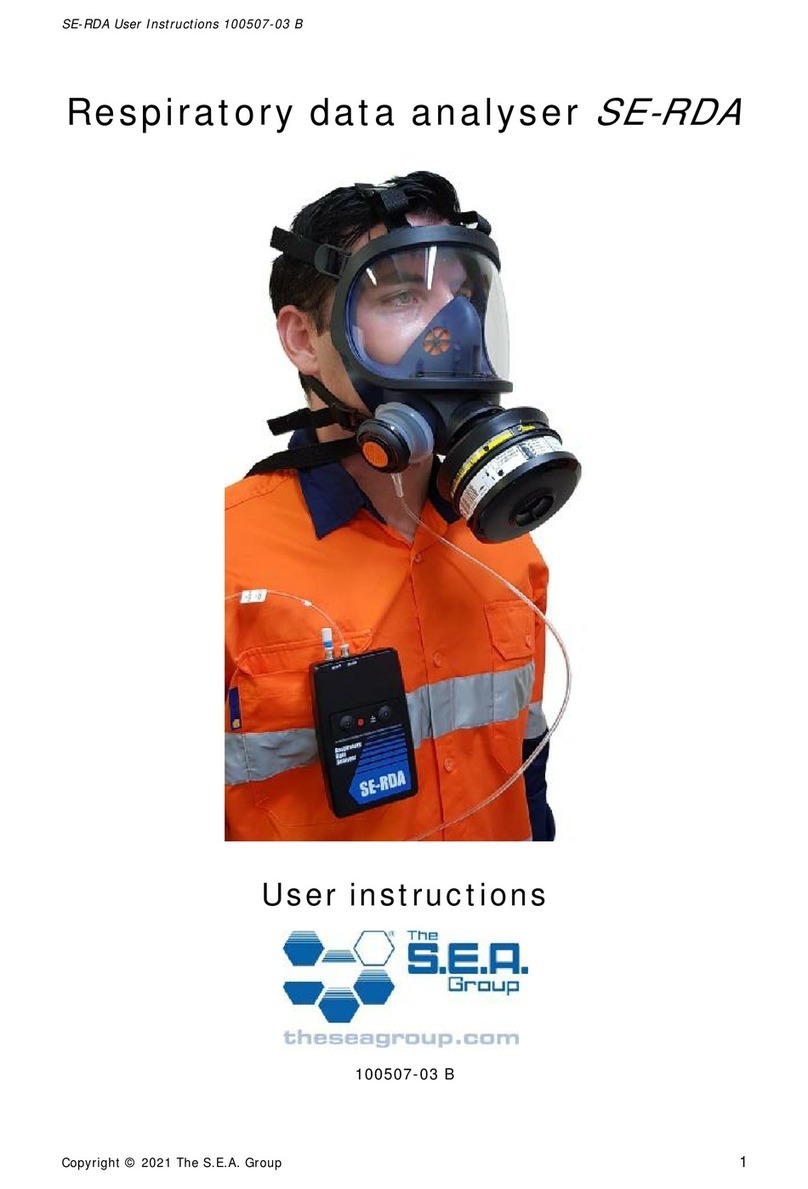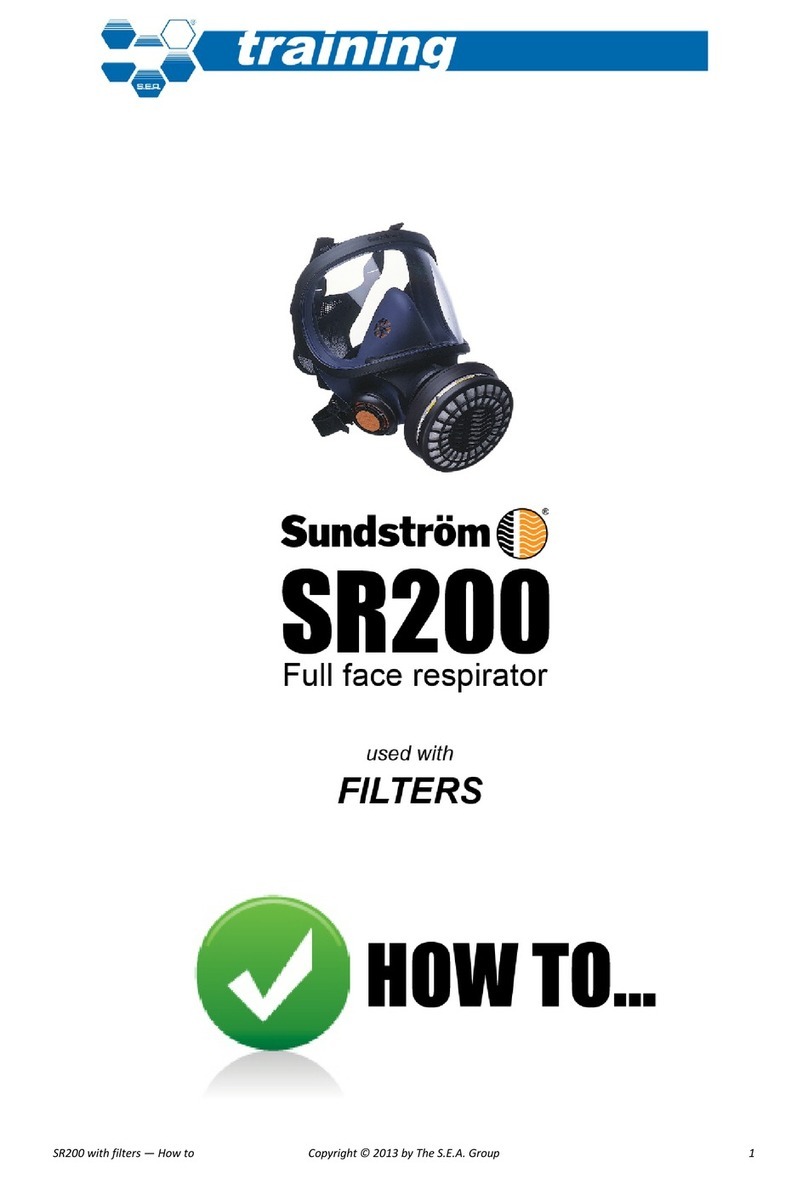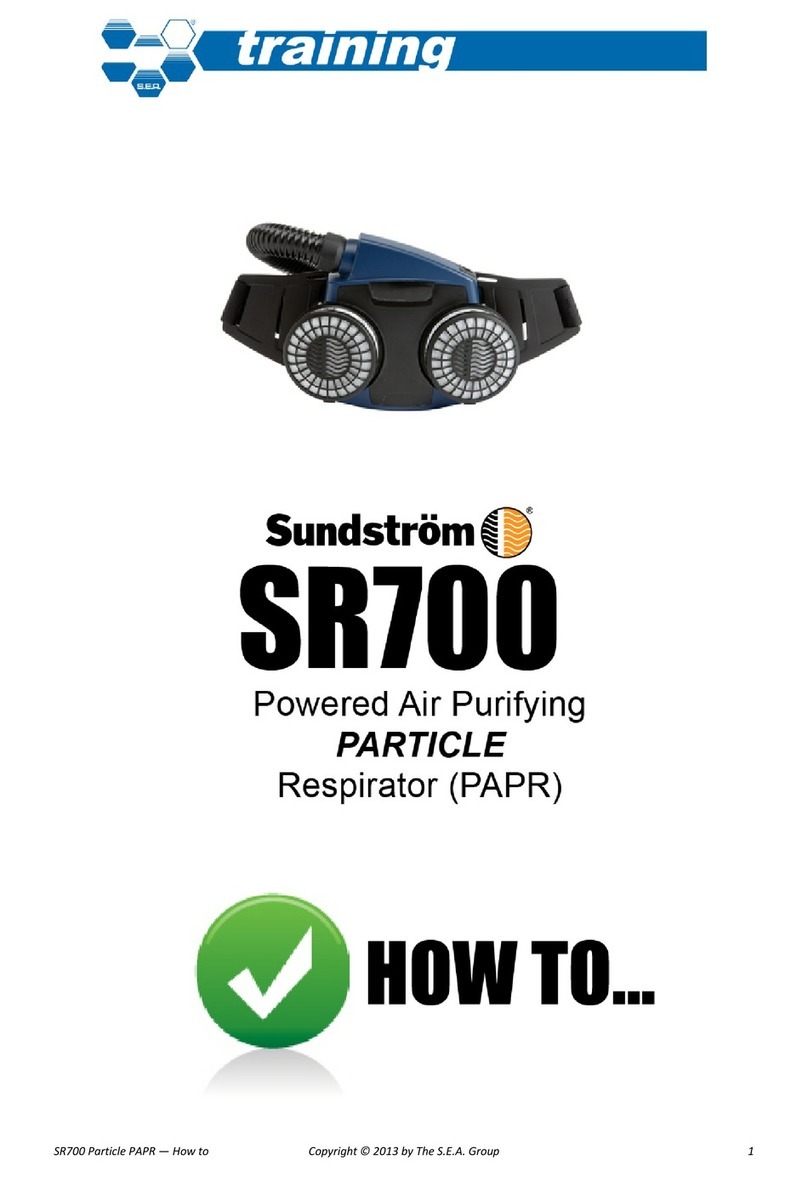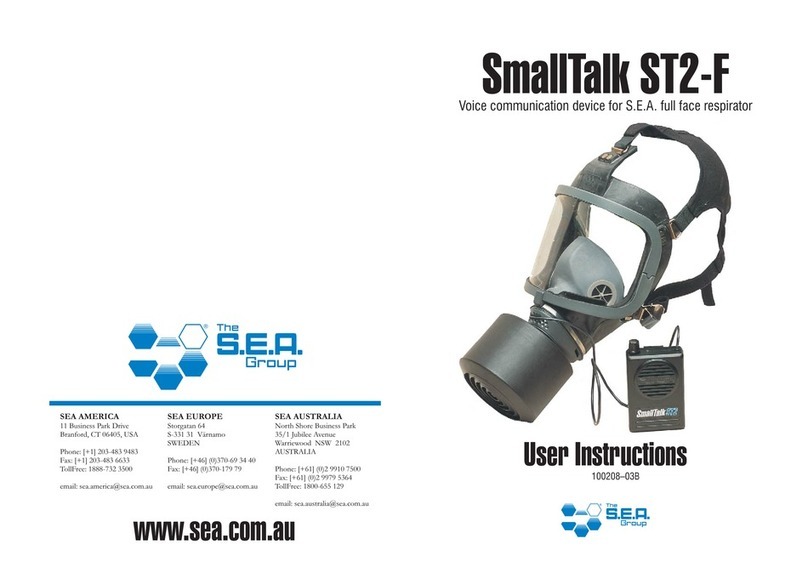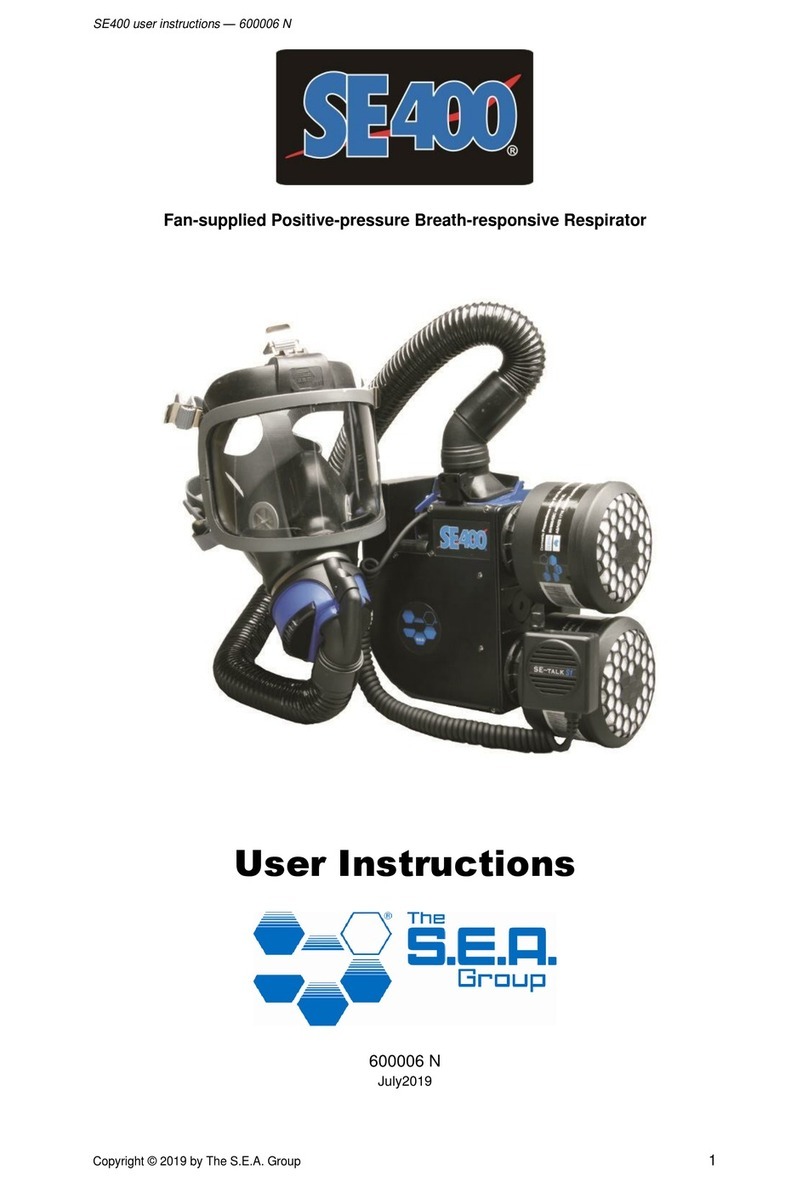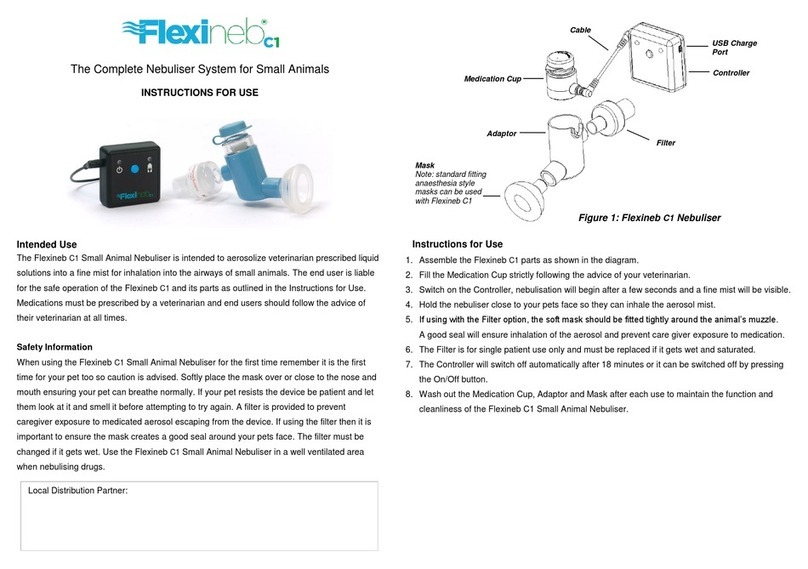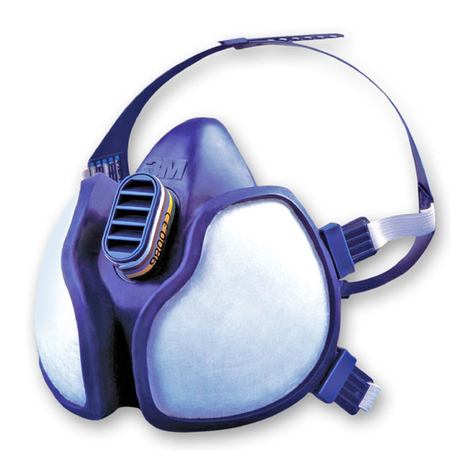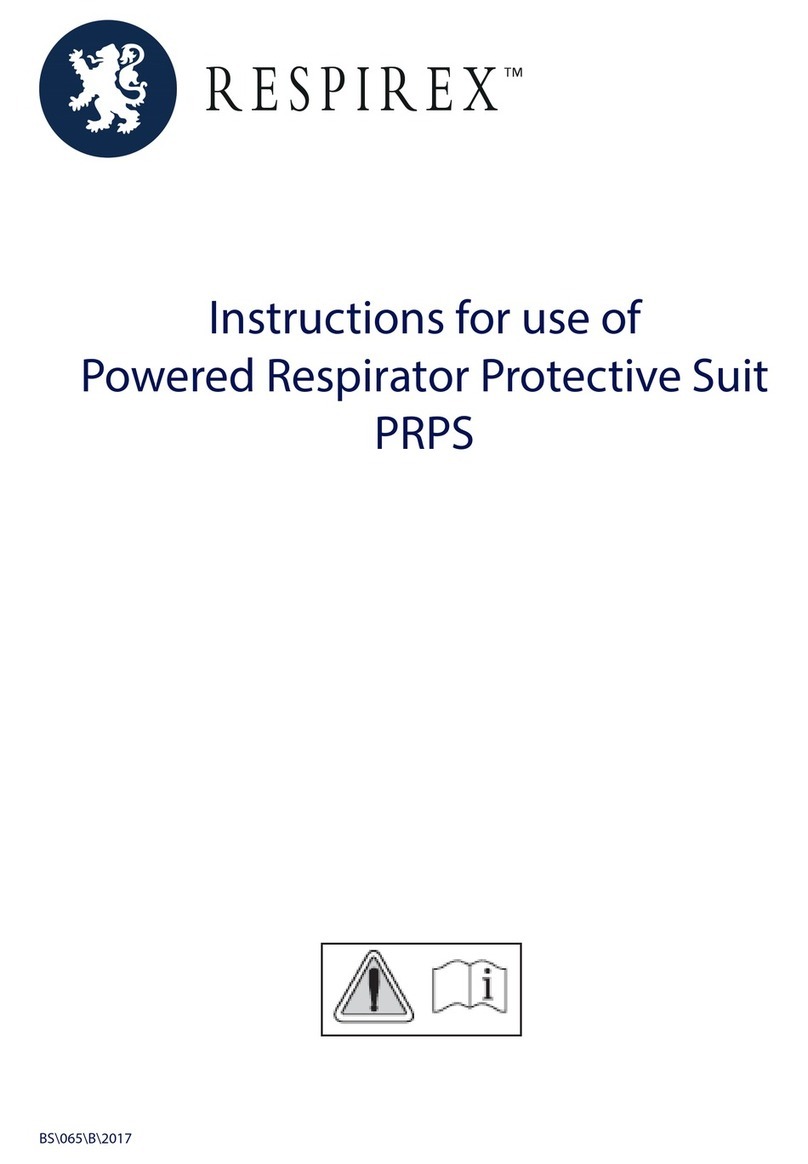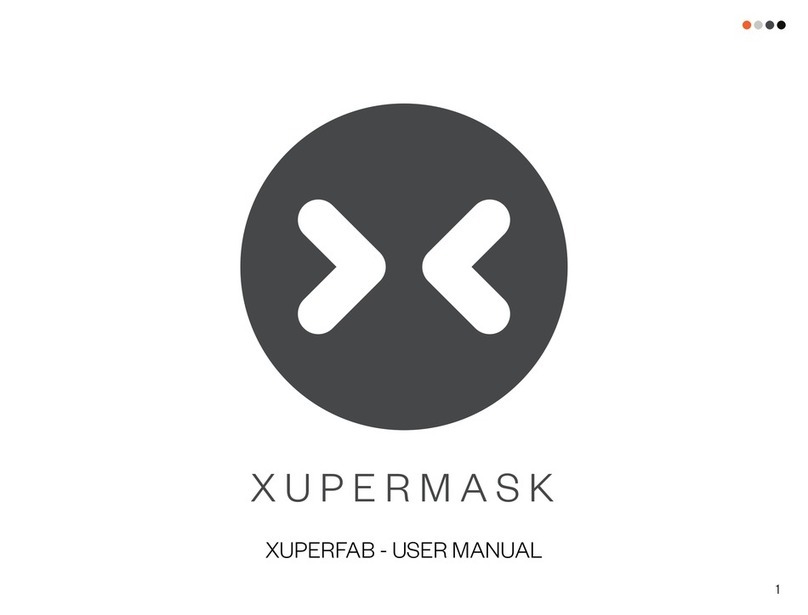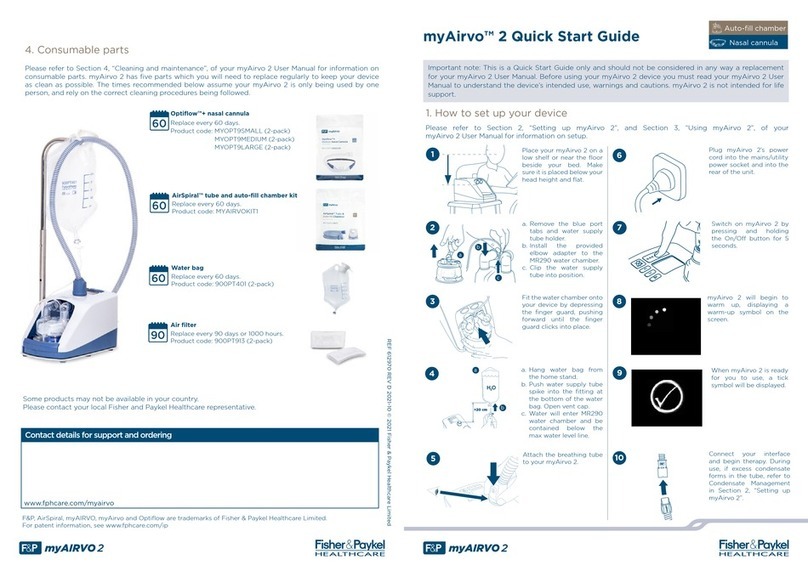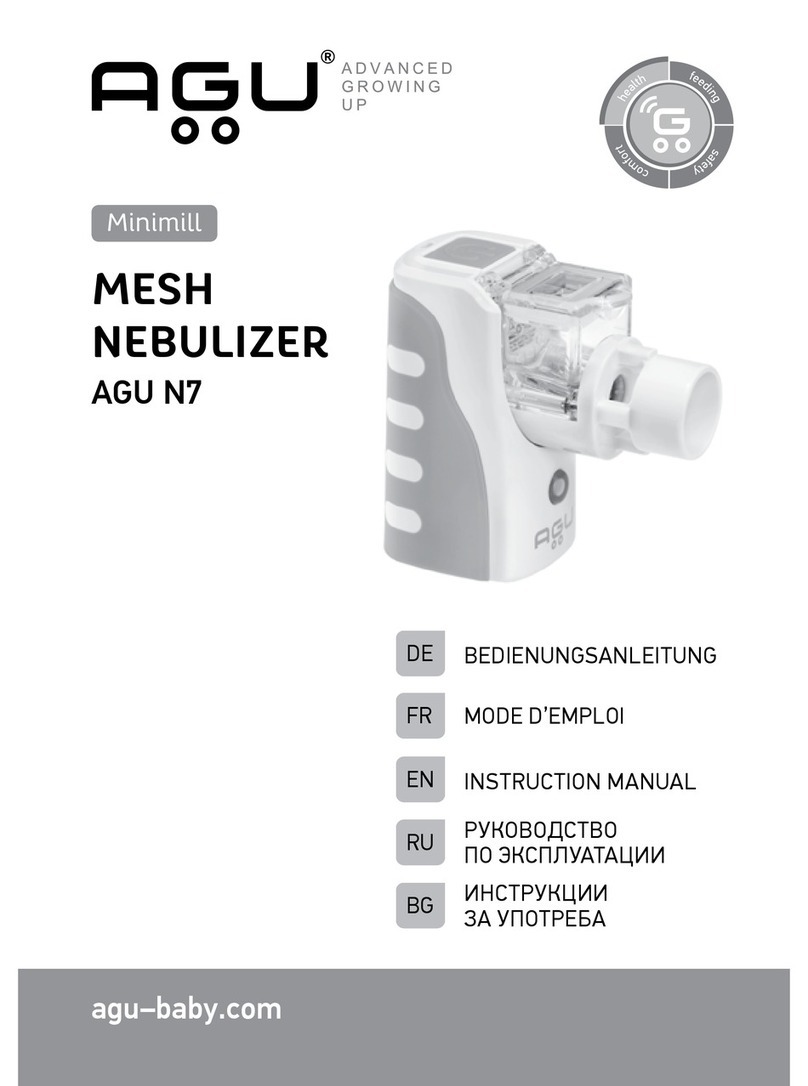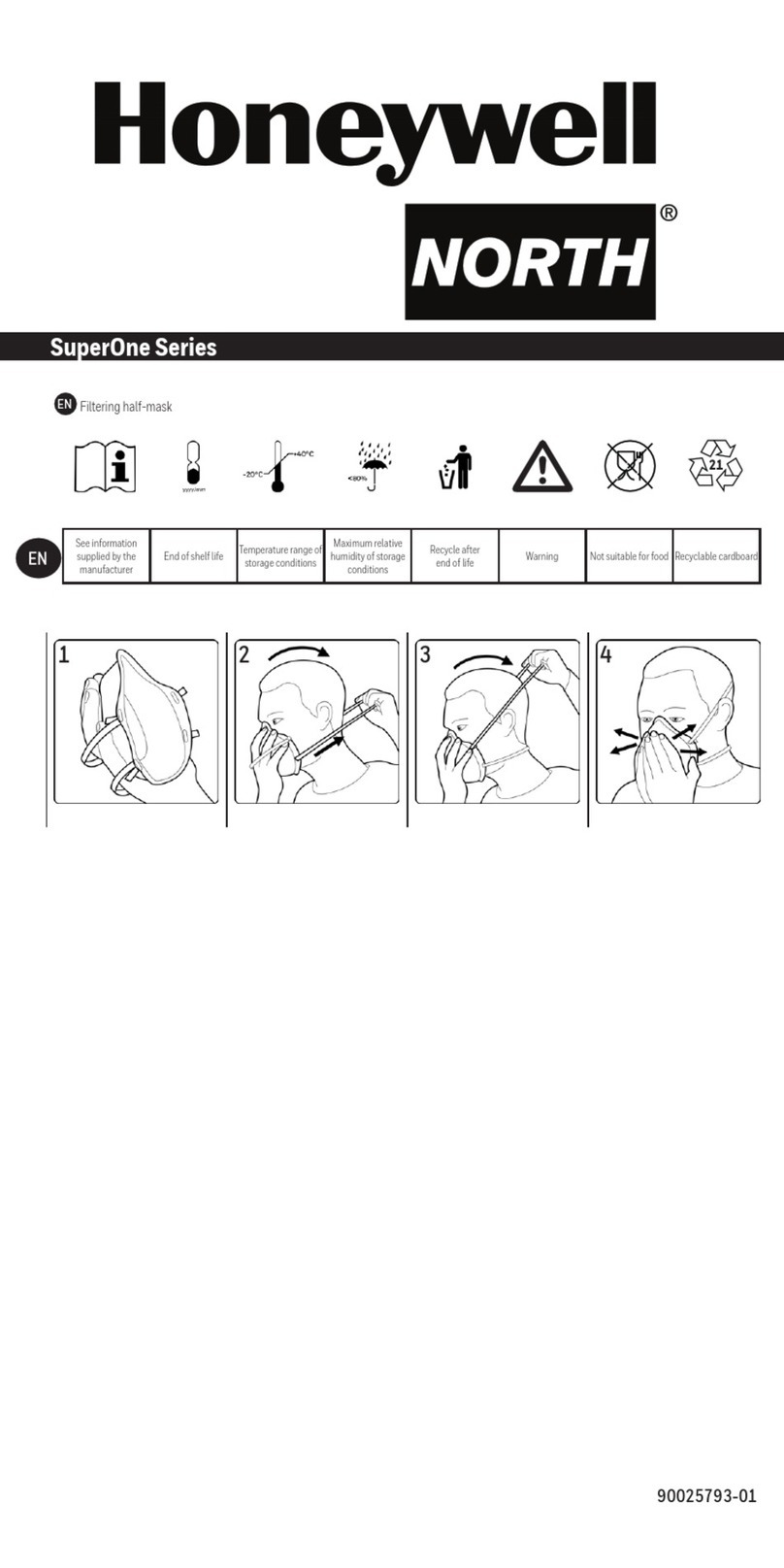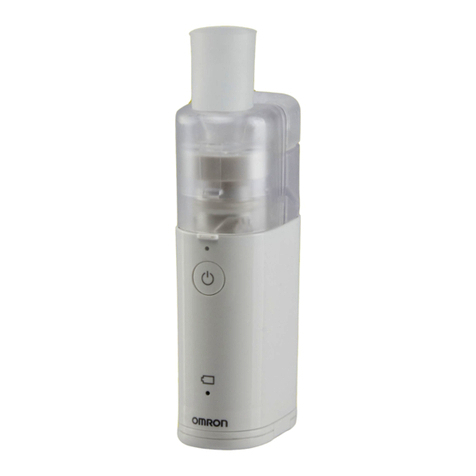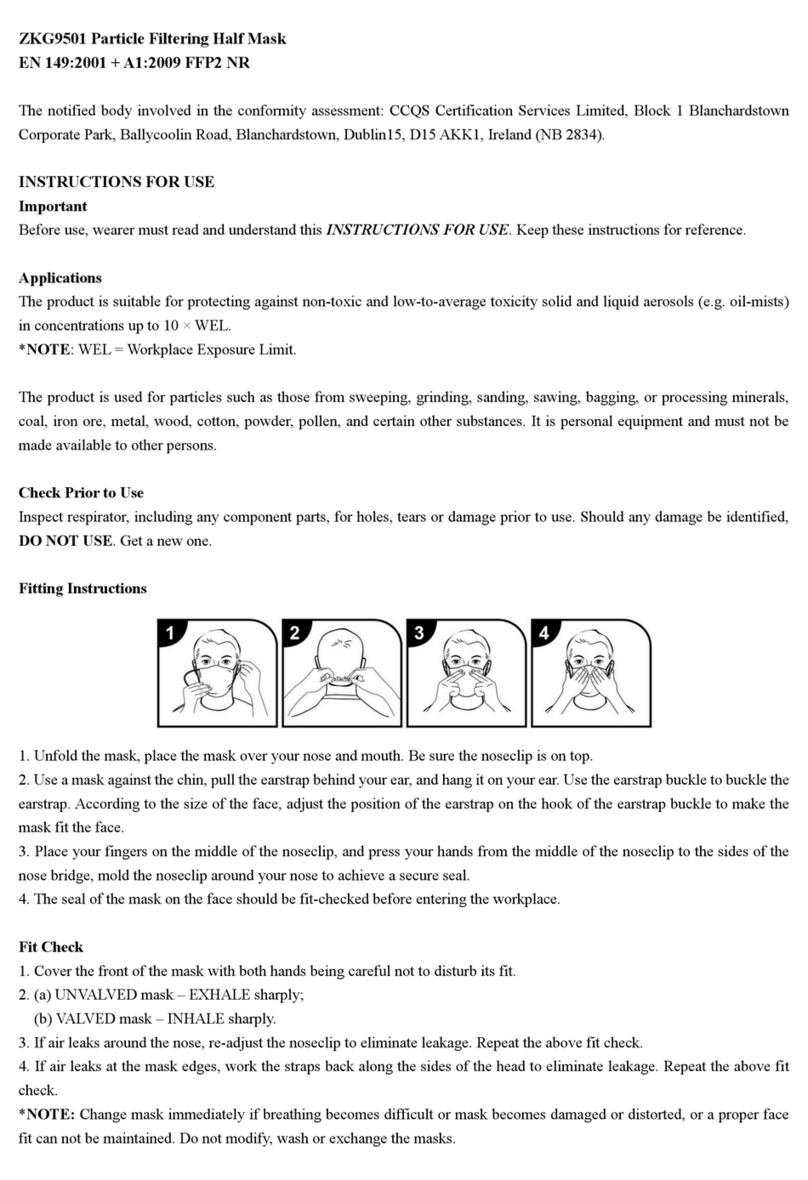S.E.A. Group SE40 User manual

SE40 User Instructions 100423-01 K
Copyright © 2019 The S.E.A. Group 1
CBRN Fan-supplied Positive-pressure Breath-responsive Respirator
User Instructions
100423-01 K
July2019

SE40 User Instructions 100423-01 K
Copyright © 2019 The S.E.A. Group 2
TABLE OF CONTENTS
ABOUT THESE USER INSTRUCTIONS.................................................................................. 3
DESCRIPTION OF THE SE40.................................................................................................. 4
Main components.................................................................................................................. 5
Features ................................................................................................................................ 5
NIOSH approval (USA) ......................................................................................................... 6
CE approval (Europe)............................................................................................................ 6
CAUTIONS AND LIMITATIONS............................................................................................... 6
UNPACKING............................................................................................................................. 8
FACEPIECE FITTING............................................................................................................... 9
QNFT Procedure................................................................................................................... 9
PREPARATION FOR USE ..................................................................................................... 11
Donning the SE40............................................................................................................... 11
WORKING IN A CONTAMINATED AREA............................................................................. 14
Decontamination ................................................................................................................. 14
STORAGE AND TRANSPORT............................................................................................... 15
COMPONENTS OF THE SE40............................................................................................... 16
Fan unit (SE40) ................................................................................................................... 16
Breathing hose (H20) .......................................................................................................... 16
SE-shield breathing hose (H20-P) ...................................................................................... 16
Facepiece............................................................................................................................ 17
Filtration media.................................................................................................................... 17
Batteries (B1) ...................................................................................................................... 18
Battery charger (BC3) ......................................................................................................... 21
Battery charger (BC1) ......................................................................................................... 21
Dual battery adapter (DB1) ................................................................................................. 22
SE-talk speaker unit (S1A-20)............................................................................................. 22
Back pack (BP2).................................................................................................................. 23
Waist belt (WB1) ................................................................................................................. 23
SE-SHIELD PROTECTIVE ENSEMBLES.............................................................................. 24
Configurations ..................................................................................................................... 24
The SE-Shield range........................................................................................................... 24
OPERATION ........................................................................................................................... 26
Visible and audible warnings............................................................................................... 26
Warnings label on fan unit................................................................................................... 26
Warnings during start-up..................................................................................................... 27
Warnings during operation.................................................................................................. 28
Stand-by mode.................................................................................................................... 28
Demist mode ....................................................................................................................... 29
Menu mode ......................................................................................................................... 29
Self-Test.............................................................................................................................. 29
DISASSEMBLY AND REASSEMBLY.................................................................................... 31
CLEANING AND MAINTENANCE ......................................................................................... 35
Reconditioning after each use............................................................................................. 35
Cleaning the demand valve................................................................................................. 35
SPARE PARTS AND ACCESSORIES................................................................................... 38
TROUBLESHOOTING............................................................................................................ 39
OPERATION IN EXTREME CONDITIONS............................................................................. 40
SE-DATA................................................................................................................................. 40
IMPORTANT WARRANTY INFORMATION........................................................................... 40
IN CASE OF HEAVY IMPACT................................................................................................ 40

SE40 User Instructions 100423-01 K
Copyright © 2019 The S.E.A. Group 3
Warning
Improper use of this respirator may result in personal injury or death. Improper use includes,
but is not limited to, use without adequate training, disregard of the warnings and instructions
contained herein and failure to inspect and maintain this respirator.
This respirator is not intended for use in atmospheres which are, or may become,
Immediately Dangerous to Life or Health (IDLH), in atmospheres where the identity and/or
concentration of the contaminant is unknown or in oxygen-deficient atmospheres.
Warning (USA)
Before occupational use of this respirator a written respiratory protection program must be
implemented meeting all the local government requirements. In the United States employers
must comply with OSHA 29 CFR 1910.134 which includes medical evaluation, training, and fit
testing.
ABOUT THESE USER INSTRUCTIONS
These user instructions refer to the following user instructions for components and accessories
of the SE40:
Supplementary manual –SE400 advanced functions (600007)
SE-shield Tychem F©(100184-04)
SE-shield Encapsulated (100292-02)
Tychem F©Hood (100259-04)
Breathing hose cover HC-TF (100257-03)
Foam insert SEA-FI (100287-03)
GBCO (600010)
Fit test adapter FTA-400 (100288-03)
Back pack BP2 (100267-03)
Exhalation valve shield EVS (201540-03)
Dual battery adapter DB1 (100273-03)
The above user instructions are supplied with the components. They are also available at The
S.E.A. Group website, www.theseagroup.com

SE40 User Instructions 100423-01 K
Copyright © 2019 The S.E.A. Group 4
DESCRIPTION OF THE SE40
The SE40 is a powered air-purifying respirator (PAPR) designed to give protection from
breathing hazards during emergency response to acts of terrorism or natural disasters. It is a
high-performance PAPR known as an FPBR (Fan-supplied Positive-pressure Breath-
responsive Respirator).
The SE40 has a built-in microprocessor that monitors the user’s breathing pattern and adjusts
the airflow to ensure continuous positive pressure in the facepiece even during high exertion.
Because the SE40 delivers breathing air only when needed, battery power and filtration media
capacity are conserved.
Positive pressure
Positive pressure increases breathing protection.
An airtight “face seal” – between the facepiece and the user’s face – is critical for good
respiratory protection. In practice it is very difficult to maintain a perfectly airtight face seal
under all conditions. Even momentary loss of sealing can greatly reduce the level of
protection.
By maintaining a slightly elevated air pressure inside the facepiece at all times, any leakage
will flow outward, thus preventing inward leakage of contaminated air to the breathing zone.
A conventional PAPR delivers an essentially constant flow of breathing air to the facepiece.
During high exertion the user may take very deep breaths that momentarily exceed the
delivery rate of the PAPR. At these times the facepiece pressure becomes negative and
inward leakage of contaminants can occur.
Because the SE40 “FPBR” is breath-responsive, continuous positive pressure can be
maintained at peak inhalation airflows up to and exceeding 350 litres per minute.
Positive pressure reduces breathing resistance.
Because the air in the breathing zone is maintained at a very small positive pressure, the user
feels little or no breathing resistance. By reducing the breathing effort and discomfort, he or
she has more energy and awareness to do the job at hand.

SE40 User Instructions 100423-01 K
Copyright © 2019 The S.E.A. Group 5
Main components
A comprehensive list of components is given in section Components of the SE40.
1. Fan unit
2. Filtration media
3. Breathing hose with protective cover
fitted
4. Facepiece
5. Demand valve
6. Exhalation valves shield
7. Battery(s)
8. SE-Talk speaker unit
9. Back pack
Features
1. ON/OFF button
2. Status lights panel
3. Communication socket
4. Two threaded connectors for filtration
media
5. Third threaded connector
permanently plugged
6. Three threaded nuts for attachment
to SE-shield protective suits
7. Warning light

SE40 User Instructions 100423-01 K
Copyright © 2019 The S.E.A. Group 6
NIOSH approval (USA)
The SE40 is approved in the USA by NIOSH for use in CBRN (Chemical, Biological,
Radiological and Nuclear) environments, where:
hazards are known and characterised
oxygen deficiency is not present
The SE40 is also approved for escape from additional unknown or unexpected hazards, such
as a secondary CBRN device.
Note (USA): The respirator components and filtration media must be used only in the
configurations indicated on the NIOSH Approval Labels.
CE approval (Europe)
The SE40 is approved in Europe to BS 8468-4:2008 for use during rescue, evacuation,
escape, hazard containment and decontamination, and similar activities by emergency
responders in areas contaminated by CBRN agents. The approval assures conformity with the
Essential Health and Safety Requirements of PPE Regulation (EU) 2016/425. Conformity was
assessed by INSPEC International Limited (notified body number 0194), 56 Leslie Hough
Way, Salford, Greater Manchester, M6 6AJ, United Kingdom.
The CE marking is as follows:
The manufacturer’s Declaration of Conformity can be found at
www.sea.com.au/seshield/docs/std_se40_eu_doc_2206.pdf
The SE40 is a Type 2A device –it is based on a full face mask and is for use by emergency
responders that do not need to use optical systems.
The SE40 respirator with 125-CBRN1-CE filter has the following classification:
BS 8468-4:2008 Class 90 TM3P SL
Note: This filter classification applies only to this standard and this filter/respirator
combination. Take care not to confuse these markings with those on a filter or device relating
to another European Standard.
Warning
Failure to choose a respirator equipped with filtration media suitable for the contaminant(s) in
the atmosphere or likely to be released in the atmosphere may result in little or no protection
and may expose the wearer to substances which can cause serious injury or death.
CAUTIONS AND LIMITATIONS
When using this respirator, observe the following cautions and limitations.
Warning
Failure to observe these Cautions and Limitations may reduce breathing protection and may
result in injury or death.
Oxygen levels
Not for use in atmospheres containing less than 19.5% oxygen.
This respirator delivers purified ambient air. It does not generate oxygen.
Breathing hazards
Not for use in atmospheres immediately dangerous to life and health (IDLH) or where
hazards have not been fully characterised.

SE40 User Instructions 100423-01 K
Copyright © 2019 The S.E.A. Group 7
For entry, do not exceed maximum use concentrations established by regulatory
standards.
(USA) The CBRN PAPR (tight-fitting facepiece) with canister approvals (TC-14G
approval labels) may be used for escape from IDLH atmospheres.
If during use an unexpected hazard is encountered, such as a secondary CBRN
device, pockets of entrapped hazard or an unforeseen hazard, immediately leave the
area for clean air.
This respirator provides respiratory protection against inhalation of radiological and
nuclear dust particles. Procedures for monitoring radiation exposure and full radiation
protection must be followed.
If you sense any of the following danger signals:
osmell or taste of contaminants
oeye, nose or throat irritation
obreathing difficulty
ouncomfortably warm breathing air
odizziness, nausea or vomiting
immediately leave the contaminated area. Do not remove the respirator until you
have reached clean air and after decontamination as required.
Some CBRN agents may not present immediate effects from exposure, but can result
in delayed impairment, illness or death.
Explosive atmospheres
Contains electrical parts which may cause an ignition in flammable or explosive
atmospheres. Do not use in flammable or explosive atmospheres.
Exposure to flame
Do not use in contact with flame. Do not use for fire fighting.
Decontamination
Direct contact with CBRN agents requires proper handling of the respirator after each
use and between multiple entries during the same use. Decontamination and disposal
procedures must be followed. If contaminated with liquid chemical warfare agents
dispose of the respirator after decontamination.
Dermal (skin) hazards
Use in conjunction with personal protective ensembles that provide appropriate levels
of protection against dermal hazard. Failure to do so may result in personal injury
even when the respirator is properly fitted, used and maintained.
Duration of use after exposure to chemical warfare agents
Do not use beyond eight (8) hours after initial exposure to chemical warfare agents to
avoid the possibility of agent permeation.
Do not use beyond two (2) hours after initial exposure to liquid chemical warfare
agents.
Follow these User Instructions
Failure to properly use and maintain this respirator could result in injury or death.
Follow these user instructions and established canister change-out schedules to ensure
canisters are replaced before breakthrough occurs.
Never substitute, modify, add or omit parts. Use only exact replacement parts in the
configuration as specified by the manufacturer.

SE40 User Instructions 100423-01 K
Copyright © 2019 The S.E.A. Group 8
Compliance with regulations
(USA) All approved respirators shall be selected, fitted, used and maintained in
accordance with MSHA, OSHA and other applicable regulations.
Use replacement parts in the configuration as specified by the applicable regulations
and guidance. Consult the respirator Approval Label (USA) for approved
configurations.
Special instructions apply
Special or critical user instructions and/or specific use limitations apply. The SE40 is
a unique design of respirator. Read the user instructions carefully before donning.
UNPACKING
The SE40 respirator is delivered in ready-to-use configuration, in its own reusable carry case
suitable for transport, handling and storage. It has an outer carton for delivery.
The carry case contains:
SE40 respirator fully assembled, consisting of:
ofan unit SE40
obreathing hose H20
oSingle-use breathing hose cover HC-TF (plus one spare, optional)
ofacepiece RF3-FP-C
odemand valve DV3-C
oexhalation valves shield EVS
obackpack BP2
ospeaker unit S1A-20
odual battery adapter DB1 (optional)
Up to two (2) batteries B1 (level of charge not assured) (optional)
Up to four (4) sealed filtration media (optional)
Battery charger BC3 (optional)
Power supply PS1 and AC power cable PC-USA for charger (optional)
Up to two (2) SE-shield Tychem F®single-use protective suits S-TYVF 1(optional)
SE-shield breathing hose H20-P for use with SE-shield suit 1(optional)
Up to two (2) Tychem F®hoods H-TYVF (optional)
SE40 user instructions
NIOSH Approval Label (USA)
Prefilters 221 and prefilter holders PFH-T (optional)
Data cable DC-A-2 for connection to PC (optional)
CD-ROM containing user instructions and management software (optional)
1Component not approved to BS 8468-4:2008.
The SE40 may be delivered with different configurations of these components. Check that all
components are received as ordered, and undamaged. After checking, repack components in
the carry case in ready-to-use configuration. For correct packing configurations, consult the
“how to pack” instructions in the carry case.
The carry case contains a chart showing how to pack the components. When not in use the
SE40 should be kept in this condition at all times to ensure the equipment is properly
protected.
Filtration media must always be stored in sealed foil packaging and carton.

SE40 User Instructions 100423-01 K
Copyright © 2019 The S.E.A. Group 9
FACEPIECE FITTING
Warning
Failure to perform a facepiece fit test may result in little or no respiratory protection and may
expose the wearer to substances which can cause serious personal injury or death.
The SE40 is designed to maintain positive pressure inside the facepiece even under conditions
of high workload and stress. However, a quality face seal is essential for optimum protection.
This is particularly important in the event that the blower unit stops operating and the SE40
must function as a negative pressure respirator.
A user must pass a Quantitative Fit Test (QNFT) and achieve a fit factor of at least 2000
before being assigned a respirator. This is a negative pressure test; i.e.: with the fan unit
disconnected or not operating.
Quantitative Fit Test
A Quantitative Fit Test (QNFT) gives a numerical measure of facepiece fit.
The user wears a respirator in a test atmosphere while an instrument compares the
concentration of the challenge agent in the test atmosphere with that inside the facepiece.
The test atmosphere may be air contaminated with an aerosol, vapour or gas. With some
instruments ambient air can be used.
The QNFT protocol must be in accordance with appropriate government regulations.
Facepiece fit testing has a number of aims:
1. To assess the suitability of the respirator for each person for use in real situations.
Due to natural variations in human facial features, no one size or style of full
facepiece can be guaranteed to fit everyone. A QNFT, properly conducted, can be
used to determine if the respirator is suitable for each user.
2. If the respirator is found to be unsuitable, to determine if the same respirator fitted
with the Full Face Mask Insert (SEA-FI) is suitable.
The Full Face Mask Insert is an adhesive-backed foam strip, inserted behind the
face seal, intended to accommodate unusual facial features or small faces. Once
again, a QNFT must be performed to determine if this configuration is suitable
for each user.
3. To train each user in the correct donning technique that will ensure a good facial fit
during future use.
It is extremely important that the donning technique learned by each user during
the QNFT is employed in all future use, where fit testing will not normally be
available. In particular, the head harness tension used to pass the QNFT should be
appropriate for extended use in real situations; if excessive harness tension is
needed to pass, the respirator should be considered unsuitable, and should not be
used by that person.
QNFT Procedure
The recommended method for performing the QNFT is with the S.E.A. Fit Test Adapter
(FTA-400). Alternatively, a modified test facepiece may be used.
Both methods are described below.
To prepare for a QNFT using the Fit Test Adapter FTA-400:
1. Detach the breathing hose from the SE40 facepiece. Do not remove the Exhalation
Valve Shield (EVS) from the demand valve

SE40 User Instructions 100423-01 K
Copyright © 2019 The S.E.A. Group 10
2. Attach the FTA-400 to the facepiece in place of the breathing hose and attach a
HE/P100 particulate filter, following the user instructions provided with the FTA-
400. The SE40 facepiece is now configured as a negative pressure respirator. The
SE40 fan unit is not required for this test
3. Check that the facepiece, demand valve, exhalation valve shield and FTA-400 are
complete and correctly assembled
4. Don the respirator in accordance with section Donning the SE40 step 2 and steps 4
through 9
To prepare for a QNFT using a test facepiece:
1. Detach the breathing hose from the SE40 facepiece. Do not remove the Exhalation
Valve Shield (EVS) from the demand valve
2. Attach to the breathing hose a modified SE40 test facepiece containing a sampling
port connecting to the breathing zone of the facepiece. The test facepiece should be
leak tested by a suitable method prior to use.
3. Fully assemble the SE40, including canisters. The SE40 can now be tested, with the
blower off, as a negative pressure respirator
4. Don the respirator in accordance with section Donning the SE40 steps 1 through 9
and step 12
To perform a QNFT:
1. Prepare and don the respirator using one of the methods described above
2. An assistant should inspect the fit of the respirator. Check for significant gaps
between the rim of the facepiece and the user’s face. If significant gaps are visible,
consider fitting the Full Face Mask Insert (SEA-FI). Doff the facepiece, fit the Insert
in accordance with its user instructions, and don the facepiece as before.
3. Enter the test atmosphere (if required) and connect the test instrument’s sampling
tube to the sampling port on the FTA-400 or test facepiece
4. Perform an appropriate QNFT exercise sequence and determine the fit factor
i. If the fit factor is 2000 or greater, the respirator should be considered
suitable for the user. No further testing is required
ii. If the fit factor is less than 2000, an observer should check that the
respirator is correctly assembled, and properly fitted in accordance
with section Donning the SE40 step 9. The user should check head
harness tension and adjust if necessary. Go to step 5 below
iii. If during step ii above the observer detects fitting problems which
cannot be overcome by adjustment –in particular, visible gaps
between sealing rim and the user’s face – the Full Face Mask Insert
(SEA-FI) may provide a solution. Doff the facepiece, fit the Insert in
accordance with its user instructions, and don the facepiece as before.
Go to step 5 below
5. Repeat the QNFT and determine the fit factor
oIf the fit factor is 2000 or greater, the respirator in the configuration tested –
with or without Insert as appropriate –should be considered suitable for the
user. No further testing is required
oIf the fit factor is again less than 2000 the respirator should be considered
unsuitable and should not be used by that person
Note: Some “trial and error” is acceptable when carrying out facepiece fit testing. Sound
judgement by experienced personnel is essential when assessing the suitability or otherwise of
a respirator. Remember that the donning and adjustment method used during testing must be
appropriate for subsequent use in real situations.

SE40 User Instructions 100423-01 K
Copyright © 2019 The S.E.A. Group 11
PREPARATION FOR USE
Donning the SE40
The user must be familiar with and practise the donning and doffing procedures prior to
respirator use.
Warning
Men should be clean-shaven, and should not have facial hair such as beards or large
sideburns. Facial hair can seriously compromise the face seal and result in reduced
protection.
Note: Before donning a respirator for the first time, perform a facepiece fit test per section
Facepiece Fitting. SEA recommends that each new (unused) respirator be tested for facepiece
fit even if the user is experienced with the respirator.
Note: Users who have been approved to use the SE40 only with Full Face Mask Insert (SEA-
FI) should check that the insert is correctly fitted and is in good condition prior to donning.
Note: Before first use and after maintenance, perform a respirator “Self-Test”. Refer section
Operation.
Note: Users should be well hydrated before donning and using the respirator.
Note: When donning the SE40 with an SE-shield protective suit, consult the SE-shield user
instructions.
Procedure:
1. Visually inspect the respirator for
completeness, correct assembly and
lack of damage
2. Put the facepiece neck strap over
your neck
3. Put the backpack on your back,
fasten and adjust the straps
4. Fully loosen the head harness straps
5. Clear all hair away from your face. A
thin elasticised head band may be
used, provided it is kept clear of the
face seal
6. Holding the facepiece in one hand
and the head harness in the other,
place your chin in the cup of the
facepiece
7. Pull the head harness over and down
the back of your head and stroke it
down. Clear any hair away from the
face seal

SE40 User Instructions 100423-01 K
Copyright © 2019 The S.E.A. Group 12
8. Tighten the head harness straps in
pairs by pulling the free ends
backwards. Start with the neck
straps, followed by the temple straps
and finally the forehead strap
9. Check that the face seal touches the
skin all around, especially under the
chin cup and at the temples. Try
moving the mask to verify that there
is no slippage. The straps should be
tightened firmly enough to prevent
movement on the face during use,
but should not be overly tight.
Excessive tightness may lead to
increasing discomfort during use.
Check once again that there is no
hair under the face seal
10. Turn on the fan unit by pressing and
releasing the button on the speaker
unit. Alternatively, press and release
the ON/OFF button on the fan unit
11. Perform a User Seal Check * by
pressing and holding the SE-Talk
button for more than three seconds,
causing the SE40 to run at full fan
speed (“Demist mode”). You should
not feel any air leakage around the
face seal. After 20 seconds the SE40
automatically returns to normal
operating mode. If any leakage is
evident, correct immediately by re-
stroking the head harness to the
back and retighten neck, temple and
forehead straps. The straps should
be tightened firmly enough to prevent
movement on the face during use,
but should not be overly tight.
Excessive tightness may lead to
increasing discomfort during use.
Check once again that there is no
hair under the face seal
12. Rotate your head and check for
comfortable, free movement. Adjust
hose swivel at mask end as required.
13. Adjust the level of the speaker unit
whilst speaking

SE40 User Instructions 100423-01 K
Copyright © 2019 The S.E.A. Group 13
14. Check the warning light in front of the
mask. It should not be lit. The audible
alarm should be silent. If not,
investigate. Do not enter a
contaminated area until it is resolved
15. Don any outer protective clothing as
required. You are now ready to enter
a contaminated area.
* Note: The User Seal Check is a simple check for gross leakage prior to use. It is not a
substitute for a quantitative fit test (QNFT).
Buddy Check
When entering a contaminated area in groups of two or more, it is good practice to perform a
“buddy check”. Pairs of users should visually inspect –but should not adjust –each other’s
respirators, checking for things like correct mask positioning, strap tightness, absence of hair
in the face seal, correct fitment of battery, hose and hose cover, filters and accessories, etc.
Check that the fan unit is operating correctly by observing the status lights panel on the fan
unit (refer to section Operation for further details).
Warning
If the facepiece has been properly donned and adjusted, detection of contaminant odour
or taste, or irritation of eye, nose or throat during use may indicate exhaustion of the
filtration media. Return to fresh air immediately without removing the respirator, check
facepiece fit and replace filtration media. Used filtration media should be disposed of
properly in accordance with state and/or local guidelines for disposal of contaminated
material.
(attach CD-ROM here)

SE40 User Instructions 100423-01 K
Copyright © 2019 The S.E.A. Group 14
WORKING IN A CONTAMINATED AREA
Before entering a contaminated environment, ensure that the SE40 is suitable for use in that
environment. Consult section Cautions and Limitations.
For information on the operation of the SE40, see section Operation.
Try to remain relaxed at all times. Breathe normally.
Do not over-exert yourself if you don’t have to. Reducing effort prolongs battery and
filtration media life.
Be aware of the SE40 warnings (facepiece warning light, audible alarm)
While moving about, take care not to catch the breathing hose or cables on obstacles.
In the event of a malfunction of the SE40, do not panic. Leave the contaminated area
quickly but safely. Do not remove the facepiece from your face until you have
reached clean air and have been decontaminated. Remember that even without the
blower operating the SE40 continues to function as a negative-pressure APR and
gives considerable protection.
If you sense any of the following danger signals:
osmell or taste of contaminants
oeye, nose or throat irritation
obreathing difficulty
ouncomfortably warm breathing air
odizziness, nausea or vomiting
immediately leave the contaminated area. Do not remove the respirator until you
have reached clean air and have been decontaminated.
Decontamination
After exposure in a CBRN environment, the respirator and the user must be decontaminated
in order to prevent contamination of clean areas, and to prevent contamination of and injury to
the user and other personnel.
Decontamination procedures should be developed as part of the organisation’s respirator
program and should be appropriate to the hazards involved.
When developing a decontamination procedure, consider the following guidelines:
The SE40 is water-resistant. It is NOT waterproof! Never submerge the SE40 in
water.
Leave the speaker unit connected to the fan unit. This will protect the connector
terminals.
Do not remove the facepiece or turn off the blower until after initial decontamination.
After removing the facepiece, do not allow direct water streams inside the facepiece.
Water may enter the fan unit through the breathing hose and cause serious damage.
Do not use compressed air when cleaning. The SE40 contains sensors for measuring
facepiece pressure and ambient pressure that may be damaged.
Filtration media should always be discarded after decontamination in a shower.
Batteries can be decontaminated in a water shower. After doing so, shake off the
water and place it on a dry surface with the contacts downwards. Batteries should be
thoroughly dry before recharging.
The breathing hose is fitted with a single-use chemically resistant cover. This cover
should be removed and discarded during decontamination. The breathing hose should
be decontaminated after the cover has been removed. A replacement cover should be
fitted ready for next use. Consult user instructions supplied with the hose cover.
Do not disconnect the breathing hose from the facepiece or fan unit during
decontamination. If disconnected, water may enter and damage the respirator.

SE40 User Instructions 100423-01 K
Copyright © 2019 The S.E.A. Group 15
Note: Before decontaminating with a high pressure shower, it is advisable to remove the
prefilters, which may become waterlogged and block the airflow.
Note: If the respirator has been exposed to chemical warfare agents, S.E.A. recommends that
the respirator be decontaminated and disposed of in accordance with state and local
guidelines for hazardous waste materials.
Note: All disposable contaminated material –such as filtration media, prefilters and
breathing hose covers –should be disposed of in accordance with state and local guidelines
for hazardous waste materials.
After decontamination, the SE40 should be repacked in its carry case as soon as possible to
prevent damage or loss of components.
After use, the SE40 should be returned to ready-to-use condition as soon as possible. This
normally involves:
thorough cleaning of external surfaces. Do not use solvents on the SE40
visual inspection for condition and completeness
replacement or repair of components as required
replenishing the SE40 carry case with spare filtration media as required
recharging of battery(s)
performing a Self-Test
ensuring all parts are dry before repacking
repacking in ready-to-use configuration
STORAGE AND TRANSPORT
The SE40 is designed to withstand harsh working conditions and inhospitable environments.
However, proper storage and transport methods will prolong the life of the respirator and
ensure it is always capable of optimum performance.
The SE40 respirator must be stored in ready-to-use configuration, in the carry case provided.
For correct packing configurations, consult the “how to pack” instructions in the carry case.
Filtration media must always be stored in sealed foil packaging and carton.
When storing or transporting the SE40, keep in mind the following points:
Store in ready-to-use configuration inside SE40 carry case. Ensure the respirator is
packed correctly. See section Ready-to-use Configuration
Store in clean and dry area
Store in ambient conditions between –20 and +55°C (–4 and +131°F) and less than
70% relative humidity. Battery may be stored at +55°C no longer than one month.
For longer term storage, consult section Battery care and maintenance.
Protect the respirator, components and carry case from potential causes of damage
such as sharp edges, heavy weights, abrasives, chemicals and moisture
Avoid sources of vibration
Do not store in direct sunlight
Do not stack SE40 respirators in carry cases more than three units high. Ideally they
should be stored in shelving without stacking
Warning
Batteries in storage do not retain full charge indefinitely. Periodic recharging is necessary to
maintain full charge. Consult section Batteries for more information on charging and
maintaining batteries.
Note: Respirators in storage require periodical inspection and maintenance. Consult section
Cleaning and Maintenance.

SE40 User Instructions 100423-01 K
Copyright © 2019 The S.E.A. Group 16
In the USA, OSHA requires that emergency use respirators be inspected at least once per
month and before and after use to ensure they are in good operating condition.
COMPONENTS OF THE SE40
Fan unit (SE40)
The fan unit SE40 contains a centrifugal blower for drawing purified air from the canisters
and delivering it under pressure to the facepiece via the breathing hose. It is constructed from
rugged ABS plastic.
The SE40 fan unit has two threaded connectors for attachment of filtration media. A third
(central) connector is permanently plugged.
The fan unit contains electronics that control the air delivery rate. It also has many advanced
functions such as warnings for filter end-of-life and filter missing, logging of important
operating data and real-time monitoring of facepiece pressure. It can be connected to a PC for
configuring the fan unit parameters and downloading operating data. Consult supplementary
manual, SE400 advanced functions.
The fan unit model number SE40 is located on the identification label on its underside.
Warning
The plug in the central filtration media connector is permanent. Do not attempt to remove it.
Removing the plug will result in damage to the fan unit and will void the warranty.
Each filter position is fitted with an external thread, gasket and nut for connection to SE-
shield suits. Consult the SE-shield user instructions for use.
Note: The SE-shield suit-sealing nuts should remain fitted to the fan unit at all times, even
when not used with a suit, in order to protect the threads from damage.
Breathing hose (H20)
The breathing hose H20 conveys purified air from the fan unit to the facepiece. It also links
the facepiece pressure detection, speech microphone and warning light to the fan unit. The
flexible hose is made from tough polyurethane.
The breathing hose should remain connected to the fan unit at all times.
The breathing hose model number H20 is located on the attachment to the fan unit, and is not
visible when the hose is fitted to the fan unit.
SE-shield breathing hose (H20-P)
The SE-shield breathing hose H20-P is used in place of the H20 when the SE40 is used with
SE-shield protective suits. The H20-P directs a small amount of filtered air from the SE40
into the suit, maintaining positive pressure inside the suit. For more information consult
section SE-shield protective ensembles.
Note: The H20-P is not approved to BS 8468-4:2008.
Breathing hose cover (HC-TF)
A single-use Tychem F®hose cover (HC-TF) is fitted to the breathing hose to provide
maximum permeation resistance against aggressive CBRN agents. The cover should always
be fitted with the SE40. The cover should be replaced after each use in a CBRN environment.
Contaminated covers should be disposed of properly in accordance with state and/or local
guidelines for disposal of contaminated material.
For fitting and removal consult the user instructions provided with the breathing hose cover
HC-TF.

SE40 User Instructions 100423-01 K
Copyright © 2019 The S.E.A. Group 17
Facepiece
Facepiece (RF3-FP-C)
The full facepiece RF3-FP-C is available in a single size to fit all faces. It is made from highly
chemically resistant halo-butyl rubber. The visor is made from high-clarity polycarbonate
with a hard coating for chemical and scratch resistance.
The demand valve regulates the air flow to the facepiece in response to the user’s breathing
requirements. It is made to S.E.A.’s patented design.
The facepiece can be identified by the
markings:
“RF3” on demand valve attachment inside
inner mask
“FP” on mask body above visor and “C” on
corner of visor
Note: If a good face fit cannot be achieved for a particular user, the S.E.A. Full Face Mask
Insert (SEA-FI) may be fitted to the mask to improve the fit. This should be done in
conjunction with a face fit testing program. See section Facepiece Fitting.
Demand Valve (DV3-C)
The demand valve DV3-C is attached to the front of the facepiece. It should remain fitted to
the facepiece at all times other than for periodic thorough cleaning or if necessary for
maintenance.
The demand valve model number DV3-C is located on the outer surface of the housing.
Exhalation Valve Shield (EVS)
The Exhalation Valve Shield is a one-piece cover that protects the exhalation valves from
contamination by external splashing. It is fitted over the demand valve and is held in place by
the breathing hose.
The Exhalation Valve Shield should always be fitted to the SE40.
The model number EVS is located inside the part.
Filtration media
Use only filtration media approved for use with the respirator. (USA) Consult the NIOSH
approval label supplied with the respirator and filtration media.
Filtration media are single-use only.
To fit the filtration media to the fan unit:
1. Check that the model number on the filtration media packaging is correct and that the
use-by date has not expired

SE40 User Instructions 100423-01 K
Copyright © 2019 The S.E.A. Group 18
2. Check that the sealed foil packaging is intact
3. Cut and tear the foil and remove the filtration media
4. Check the filtration media for damage. Filtration media with visible physical damage
should be discarded immediately
5. Check that the threads on the filtration media and fan unit are clean and the gaskets in
the fan unit are clean, undamaged and properly seated
6. Screw each of the filtration media into the fan unit and tighten firmly. Spin the filter
until it begins to tighten, then turn another 120º or so (slightly more than a quarter
turn). Take care not to overtighten. Note that the fan unit gasket has a self-locking
design, so the turning resistance will increase steadily as the canister is tightened.
To remove the filtration media from the fan unit:
1. Simply unscrew and remove.
Batteries (B1)
The SE40 is powered by one or two rechargeable Nickel Metal Hydride (NiMH) batteries.
Batteries can be easily interchanged. If used and maintained correctly a battery will give a
service life of up to 500 charge/discharge cycles.
Single battery configuration
When used in single battery configuration, the battery is fitted directly to the SE40 fan unit.
Dual battery configuration
The Dual Battery Adapter is used to provide dual battery configuration for the SE40, giving it
extended operating time. See section Dual Battery Adapter.
Battery operating time
The operating time of the SE40 when fitted with fully charged battery or batteries greatly
depends on the workload of the user, in the same way that a motor vehicle’s fuel consumption
depends on the load, terrain and manner of driving.
Prolonged periods of high exertion and/or stress will significantly reduce the operating time.
In these situations the user can expect a shorter available working time in a contaminated
area.
NIOSH has certified the operating time of the SE40 at 4 hours minimum, in both single and
dual battery configurations, under standard test conditions (38 litres per minute) when tested
on a breathing machine (USA).
Warning
The above operating times are not guaranteed in real situations. Actual operating times may
be significantly longer or shorter, depending on working conditions.
Note: Operating time is affected by the following:
Conditions of use. High breathing rates will result in reduced operating time.
Level of charge of battery(s). Only fully charged batteries should be fitted to the SE40
before use.
Battery condition. Batteries degrade over their working lives. A battery nearing the
end of its life will have a reduced capacity. A battery should be replaced when the
operating time has reduced significantly.
Battery temperature. Towards the upper end of the operating temperature range of
the SE40 (see section Specifications) battery performance diminishes only slightly. At
battery temperatures below 5°C (41°F) , capacity diminishes sharply. Allow batteries
to cool after charging and before use.

SE40 User Instructions 100423-01 K
Copyright © 2019 The S.E.A. Group 19
Low battery warning
The SE40 gives a series of audible and visible warnings as the end of operating time
approaches. The first low-battery warning occurs approximately 5 minutes before the SE40
shuts down. The warning time is independent of the operating conditions.
Note: The SE40 provides full breathing performance at all times until the fan unit shuts down
due to low battery level.
Warning
Old batteries in poor condition may cause the low battery warning time to be reduced.
Battery care and maintenance
Batteries in storage do not retain full charge indefinitely. Periodic recharging is recommended
to maintain full charge.
Never allow a battery to become fully flat whilst in storage. A fully discharged battery may
suffer permanent degradation over time.
Ideally, batteries should be stored in the temperature range 10 to 25°C (50 to 77°F) to
minimise degradation during long-term storage.
Batteries in long-term storage should be recharged at least once per year, and preferably every
six months, to minimise degradation.
Optimum battery condition is maintained by storing batteries in the Gang Battery Conditioner
(GBCO) (not supplied with the SE40 respirator). When stored in the GBCO, batteries receive
regular conditioning cycles and are maintained in ready-to-use condition, with close to full
charge. Consult the user instructions provided with the GBCO.
Warning
If handled incorrectly, NiMH batteries can leak toxic electrolyte, and in some circumstances
explosion may occur. Be sure to observe the following safety precautions:
Never disassemble a battery
Never short-circuit the terminals of a battery. Do not carry or store a battery with other
metal objects as short-circuiting may result
Never heat a battery or dispose of it by fire. Leakage and explosion may result
Never leave a battery exposed to direct sunlight, or close to a source of heat, for
extended periods whilst not in use
Never immerse a battery in water or other liquid
The battery is designed specifically for the SE40 and SE400 range of respirators. Do
not attempt to use it to power any other equipment.

SE40 User Instructions 100423-01 K
Copyright © 2019 The S.E.A. Group 20
To attach the battery to the fan unit:
1. Check that the contacts on the
battery and the fan unit are clean and
intact
2. Withdraw the locking slide on the fan
unit
3. Press the locking tongue
4. Hook the battery onto the fan unit.
The two posts on the fan unit should
engage with the sockets on the
battery
5. Swing the battery into place and
release the locking tongue
6. Push the locking slide back into place
7. Check that the battery is securely
fastened
To remove the battery from the fan unit:
1. Withdraw the locking slide
2. Press the locking tongue, releasing
the battery
3. Push the locking slide back into place
Table of contents
Other S.E.A. Group Respiratory Product manuals
